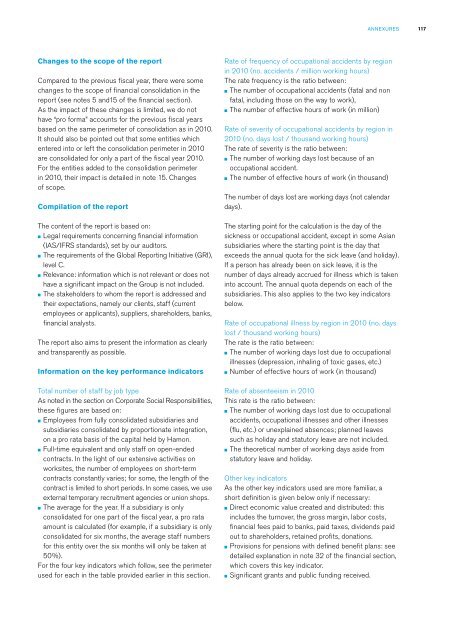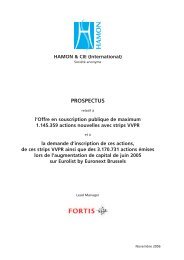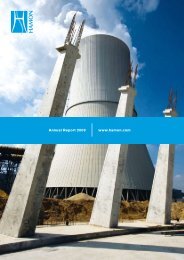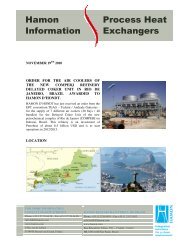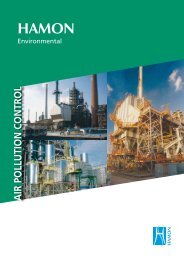Download PDF version English(2664KB) - Hamon
Download PDF version English(2664KB) - Hamon
Download PDF version English(2664KB) - Hamon
Create successful ePaper yourself
Turn your PDF publications into a flip-book with our unique Google optimized e-Paper software.
Annexures<br />
117<br />
Changes to the scope of the report<br />
Compared to the previous fiscal year, there were some<br />
changes to the scope of financial consolidation in the<br />
report (see notes 5 and15 of the financial section).<br />
As the impact of these changes is limited, we do not<br />
have “pro forma” accounts for the previous fiscal years<br />
based on the same perimeter of consolidation as in 2010.<br />
It should also be pointed out that some entities which<br />
entered into or left the consolidation perimeter in 2010<br />
are consolidated for only a part of the fiscal year 2010.<br />
For the entities added to the consolidation perimeter<br />
in 2010, their impact is detailed in note 15. Changes<br />
of scope.<br />
Compilation of the report<br />
The content of the report is based on:<br />
■ Legal requirements concerning financial information<br />
(IAS/IFRS standards), set by our auditors.<br />
■ The requirements of the Global Reporting Initiative (GRI),<br />
level C.<br />
■ Relevance: information which is not relevant or does not<br />
have a significant impact on the Group is not included.<br />
■ The stakeholders to whom the report is addressed and<br />
their expectations, namely our clients, staff (current<br />
employees or applicants), suppliers, shareholders, banks,<br />
financial analysts.<br />
The report also aims to present the information as clearly<br />
and transparently as possible.<br />
Information on the key performance indicators<br />
Total number of staff by job type<br />
As noted in the section on Corporate Social Responsibilities,<br />
these figures are based on:<br />
■ Employees from fully consolidated subsidiaries and<br />
subsidiaries consolidated by proportionate integration,<br />
on a pro rata basis of the capital held by <strong>Hamon</strong>.<br />
■ Full-time equivalent and only staff on open-ended<br />
contracts. In the light of our extensive activities on<br />
worksites, the number of employees on short-term<br />
contracts constantly varies; for some, the length of the<br />
contract is limited to short periods. In some cases, we use<br />
external temporary recruitment agencies or union shops.<br />
■ The average for the year. If a subsidiary is only<br />
consolidated for one part of the fiscal year, a pro rata<br />
amount is calculated (for example, if a subsidiary is only<br />
consolidated for six months, the average staff numbers<br />
for this entity over the six months will only be taken at<br />
50%).<br />
For the four key indicators which follow, see the perimeter<br />
used for each in the table provided earlier in this section.<br />
Rate of frequency of occupational accidents by region<br />
in 2010 (no. accidents / million working hours)<br />
The rate frequency is the ratio between:<br />
■ The number of occupational accidents (fatal and non<br />
fatal, including those on the way to work),<br />
■ The number of effective hours of work (in million)<br />
Rate of severity of occupational accidents by region in<br />
2010 (no. days lost / thousand working hours)<br />
The rate of severity is the ratio between:<br />
■ The number of working days lost because of an<br />
occupational accident.<br />
■ The number of effective hours of work (in thousand)<br />
The number of days lost are working days (not calendar<br />
days).<br />
The starting point for the calculation is the day of the<br />
sickness or occupational accident, except in some Asian<br />
subsidiaries where the starting point is the day that<br />
exceeds the annual quota for the sick leave (and holiday).<br />
If a person has already been on sick leave, it is the<br />
number of days already accrued for illness which is taken<br />
into account. The annual quota depends on each of the<br />
subsidiaries. This also applies to the two key indicators<br />
below.<br />
Rate of occupational illness by region in 2010 (no. days<br />
lost / thousand working hours)<br />
The rate is the ratio between:<br />
■ The number of working days lost due to occupational<br />
illnesses (depression, inhaling of toxic gases, etc.)<br />
■ Number of effective hours of work (in thousand)<br />
Rate of absenteeism in 2010<br />
This rate is the ratio between:<br />
■ The number of working days lost due to occupational<br />
accidents, occupational illnesses and other illnesses<br />
(flu, etc.) or unexplained absences; planned leaves<br />
such as holiday and statutory leave are not included.<br />
■ The theoretical number of working days aside from<br />
statutory leave and holiday.<br />
Other key indicators<br />
As the other key indicators used are more familiar, a<br />
short definition is given below only if necessary:<br />
■ Direct economic value created and distributed: this<br />
includes the turnover, the gross margin, labor costs,<br />
financial fees paid to banks, paid taxes, dividends paid<br />
out to shareholders, retained profits, donations.<br />
■ Provisions for pensions with defined benefit plans: see<br />
detailed explanation in note 32 of the financial section,<br />
which covers this key indicator.<br />
■ Significant grants and public funding received.


